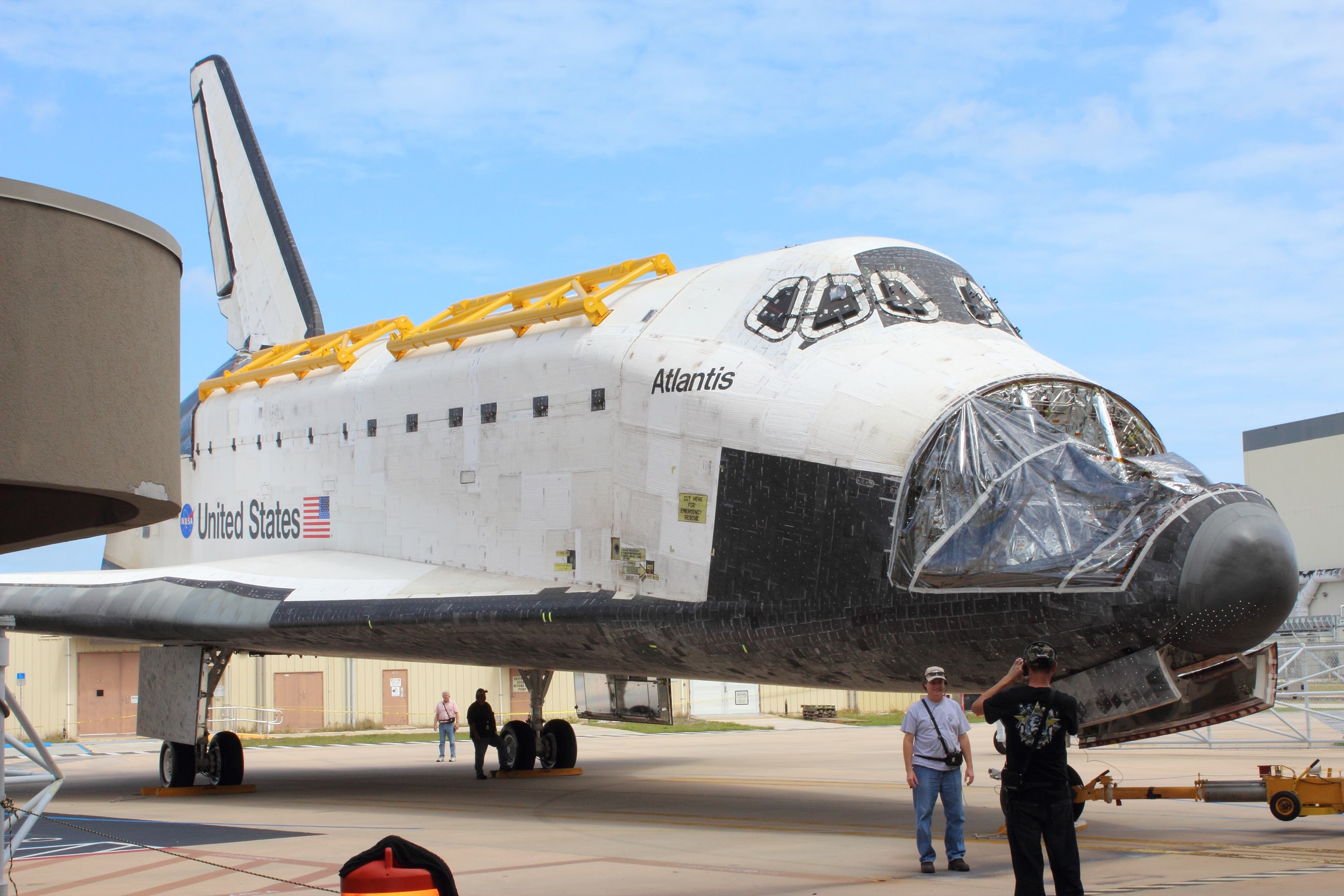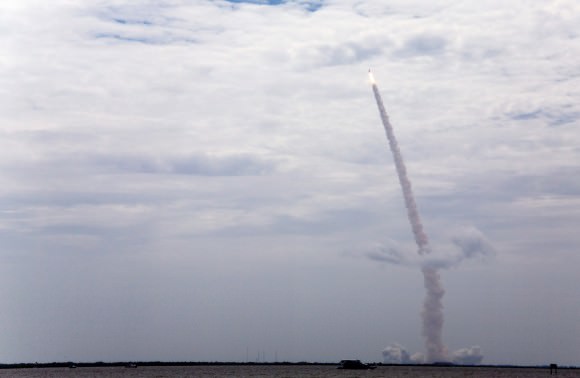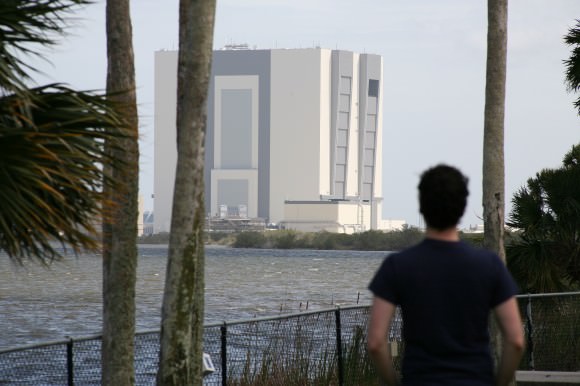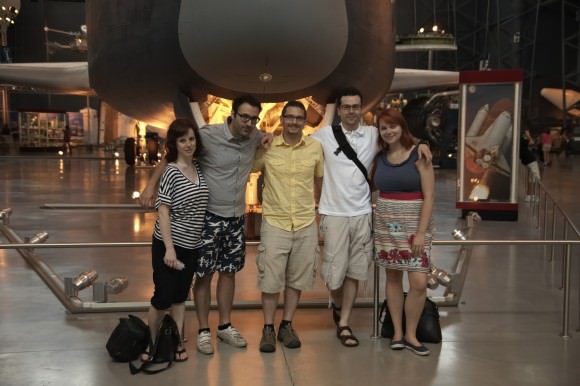Shuttle Atlantis as it enters the Vehicle Assembly Building (Ryan Horan.)
Take five shuttle fans and a once-in-a-lifetime experience, mix in some artistic creativity, and you will understand the enthusiasm and love behind the Chasing Atlantis film production.
Five Canadians made the trek to Florida to watch the final shuttle launch last year. They are wrapping up filming and interviews — which included astronauts and sci-fi stars — to discuss the legacy of the program.
They plan to release Chasing Atlantis in November. Team member Matthew Cimone talked to Universe Today by e-mail about why they made the journey in the first place.
UT: What is your connection to space?
There were five of us in total. Matthew Cimone, Paul Muzzin, Melanie Godecki, Chris Bourque and Rebecca Mead. We ranged from total space geeks and sci-fi junkies to those who were simply interested in being part of an adventurous road trip.
– Matthew had a deep personal connection to shuttle in that he had a childhood dream of becoming an astronaut that was foiled by myopia. He now gives public speeches through his site No Borders From Orbit, which promotes awareness of social justice issues through a space sciences/science fiction lens.
– Paul is a filmmaker from Sheridan College in Ontario. Also a space aficionado, Matthew recruited Paul and Paul’s studio, Riptide Media, to help bring the documentary to life. Paul is serving as director and editor on the film.
– Melanie is a photographer by trade and came along to do production stills. Her favorite photographer, Annie Leibovitz, shot several shuttle and Apollo astronaut portraits, and so she was excited to take advantage of this once in a lifetime opportunity.
– Matthew attended university with Chris and Rebecca and they both came to support the journey and by provided much needed second vehicle for our convoy. Despite our love of space, none of us had seen a shuttle launch in person. Matthew rallied together the group as his last opportunity to participate in the shuttle program and wanted to bring as many people with him as possible. You can only fit so many in two cars, but you can bring many more with you if have a camera.
UT: How did you get down there? What did you do while you were on site?
We drove the entire journey from Toronto to the Titusville/Cocoa Beach area. Along the way, we stopped at the Smithsonian Air and Space Museum to shoot prototype shuttle Enterprise before it was moved to New York City. We felt Enterprise, which marked the start of the shuttle program, also made a great start for our journey.
We left Toronto on July 4 and arrived in Titusville on the evening of July 5. Prior to Atlantis’ launch we shot everything we could on the Kennedy Space Center grounds, including Atlantis on the launch pad. The “space culture” in Southern Florida is undeniable. It permeates everything around you. Businesses are space themed, the Vehicle Assembly building and launch towers can always be seen on the horizon. And a huge percentage of the population is employed by the space industry or tourism related to space travel; a large concern in the shadow of Shuttle’s retirement
UT: Had any of you seen shuttle launches before, or visited the Kennedy Space Center before?
Matthew had been to the Kennedy Space Center as a young child, but only had vague memories of the journey. He admitted that after discovering he couldn’t make the air force, (a common route for astronauts to take to becoming part of the space program), he buried some of his interest in shuttle for many years. This was an awakening of sorts and a chance to reconnect with that childhood wonder of escaping Earth’s gravity.
Many of the team felt like big kids while wandering the halls of the Kennedy Space Center or the Smithsonian. But this was the first launch for all of us. It was an experience you’ll never forget, especially when you get hit with the rumbling shockwave even 15 kilometres away from the launch pad.
Atlantis lifts off for the last time. (Melanie Godecki)
4) Who was interviewed?
We have been incredibly blessed by the interviews we conducted. We have sat down with Canadian astronaut and future International Space Station Commander Chris Hadfield, 2003-2007 director of the Kennedy Space Center James Kennedy, American astronaut Story Musgrave, Star Trek: The Next Generation actor and Big Bang Theory guest star Wil Wheaton, a dozen NASA software and hardware engineers, and a host of interviews with those who had traveled the globe to see the shuttle launch.
What did we learn from these amazing individuals? Chris Hadfield spoke of the fragility of Earth. Wil Wheaton referred to space as the place where those who felt like they didn’t fit in at home would fit in. James Kennedy referred to the “I” in International Space Station.
We learned that space unifies and it humbles.We still treat the world, and its people, using the map we created when we only had sailing vessels – but not as if we have seen the world with space vessels. The colored maps and borderlines we teach do not exist when looking down on the Earth from above. And the social ills suffered by those across the planet are difficult to dismiss as somebody else’s problem when you can circle the globe in just 90 minutes.
Likewise, when you turn Hubble to the stars, you see that our planet is the only place we can inhabit that will support us and we don’t always treat it as such. Commander Hadfield described the Earth’s atmosphere appearing as thin as the “peel of an onion.” Our planet is fragile, and its people diverse but interconnected. Space provides a perspective that really galvanizes our planet. That unity of spirit was shown to be true as we stood with nearly one million people on the shores of Titusville who had come to see Atlantis fly.
In terms of the future, we are trying to negotiate an interview with members of the leadership team at new space asteroid mining company Planetary Resources.
5) How did you get into the VAB, and what did you see there?
During our trip, we had written the Chasing Atlantis Twitter account and site URL on our cars (along with various hand-drawn shuttles and stars that were somewhat recognizable). A NASA software engineer, Ryan Horan, saw our car with Paul shooting out the window as we passed by the sign for the Kennedy Space Center. He was interested in our project and sent us a tweet.
Ryan arranged for us to join one of the first tours following the reopening of the Vehicle Assembly Building to the public. It had been closed off since the start of the shuttle program in 1981. The building is monstrously huge. It will generate its own weather system inside, sometimes producing micro-rain clouds. Hung on the VAB walls dozens of meters in the air are banners dedicated to each mission, all signed by members of the crew and tourists who had come to wish the crews a safe journey.
Endeavour was parked inside. Endeavour’s landing was a precursor to Chasing Atlantis. Watching the orbiter fly in for its final landing (the second last shuttle mission) inspired us to see Atlantis. But that wasn’t our last journey to the VAB. We returned this past March to see both Discovery as well as Atlantis itself. We had “caught” the shuttle on take-off but in the VAB, we were only 30 feet away from the nose of this iconic vehicle.
Matthew Cimone and the Vehicle Assembly Building. (Supplied photo)
6) How did you fund the film?
The film was completely self-funded as an independent project straight from credit cards and lines of credit. We will be posting an Indie-Go-Go or Kickstarter profile up in hopes of helping to cover the post-production costs related to things such as follow up interviews and the musical score.
The film is being produced through Riptide Media. Matthew provided the initial vision for the film and is writing the narration, while Paul is bringing the feature-length documentary to life through the incredible footage he shot and is presently editing. All of us still have day jobs. For example, Matthew currently works as a residence life co-ordinator at Simon Fraser University. The University has been supporting Matthew’s efforts with the film by promoting Chasing Atlantis through its networks. We expect Chasing Atlantis to be completed by November of this year.
UT: What has been the response to the film so far?
Outstanding! The interviews we secured alone demonstrate an interest not only in the film, but for sharing the experience of space travel and how it has influenced so many people. Of those we spoke to, we sensed a certain catharsis in being able to talk about shuttle and the transition to “what’s next”.
We recently showed an extended preview at the Polaris science fiction and fantasy convention in Toronto, Ontario. Our two sessions at the convention were standing room only, and brought forward many sci-fi and space fans who shared anecdotes about their first time seeing shuttle and hopes for a strong future for human space exploration.
UT: What is your goal in releasing the film?
We are sharing a personal journey, but one that we believe will resonate with a wider community of space and science fiction fans. As one Polaris convention goer told us following our preview, “It was like I was there with you.” That’s the feeling we wanted to convey. You can go to Discovery Channel for the technology. However, while the technology served as the backdrop for our story, Chasing Atlantis is really about people; about the pursuit of a dream, about taking risks and about exploration both of space but also of oneself.
UT: What do you think was the legacy of the shuttle program?
There is debate on the shuttle’s effectiveness. Being a reusable space vessel, it was intended to reduce the overall cost of bringing payloads to space. At the end of the program, space travel is still far more expensive than was anticipated; by a factor of thousands.
Shuttle also didn’t have the best safety record. Two catastrophic failures over the course of the program is a level of risk many deemed unacceptable.
However, the two accomplishments that stood out the most among our interviewees were the International Space Station and the Hubble Space Telescope. The ISS has allowed us to have a permanent human presence in space for over 10 years now, and is a platform for us to conduct research on the effects of long-term space travel on the human body. Hubble has provided us with an unprecedented understanding of the universe. It has provided astronomical vistas that define beauty, helped us better understand how planets are formed and shown us images of the most distant and earliest galaxies which began to take shape billions of years ago.
Without the shuttle, neither the ISS nor Hubble would’ve been possible.
UT: Is there anything else you would like to include?
A huge thank you to those who supported us in the creation of Chasing Atlantis, our first film. We invite anybody who has a passion for space, feels that the continuation of space exploration is important, or just wants to geek out to connect with us. You can find us online (www.chasingatlantis.com) , on twitter (@chasingatlantis and @riptidestudios), and on Facebook. Chasing is all about community, and connecting with that community that is truly important to us!
Chasing Atlantis team with shuttle Enterprise. (Supplied photo)
Elizabeth Howell (M.Sc. Space Studies ’12) is a contributing editor for SpaceRef and award-winning space freelance journalist living in Ottawa, Canada. Her work has appeared in publications such as SPACE.com, Air & Space Smithsonian, Physics Today, the Globe and Mail, the Canadian Broadcasting Corp., CTV and the Ottawa Business Journal.





Shuttle’s legacy?
Keeping 20,000 scientists and engineers employed whether it launched or not.
Shuttle’s legacy?
Watergate wasn’t the worse thing Nixon did.
tinyurl.com/cyk9xz2
.